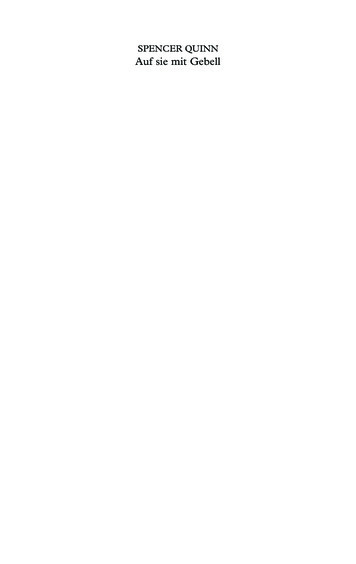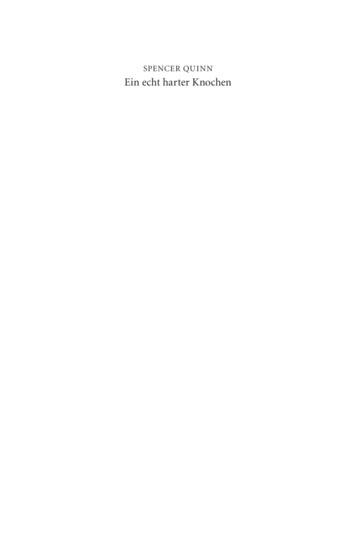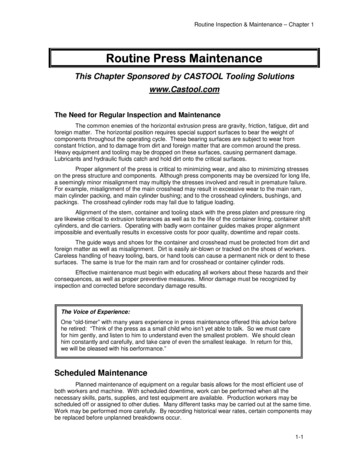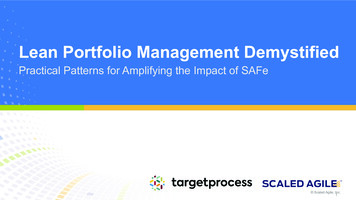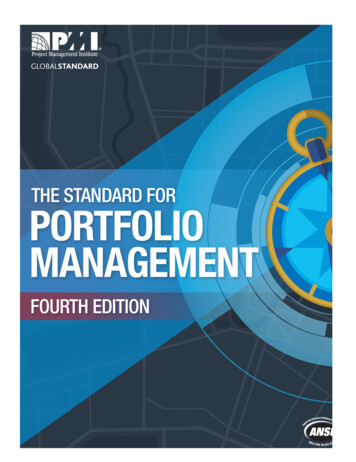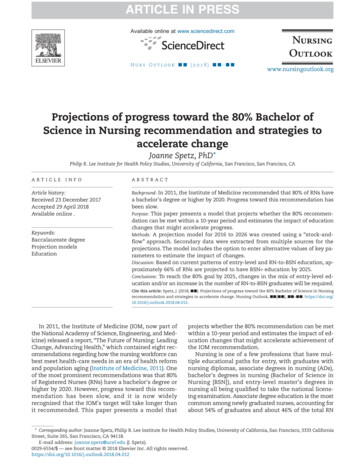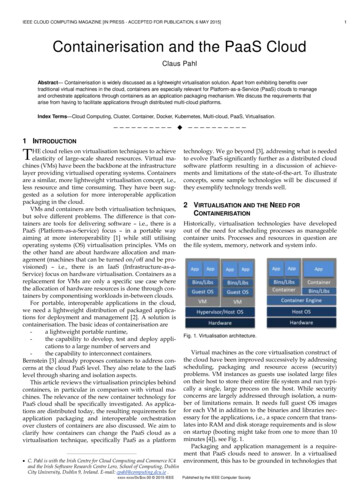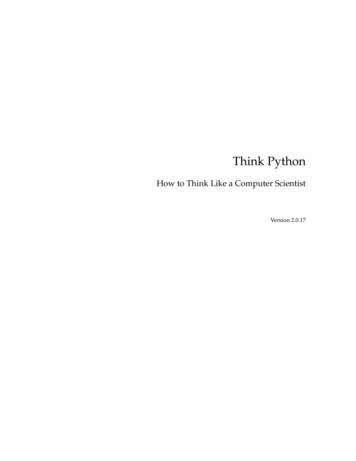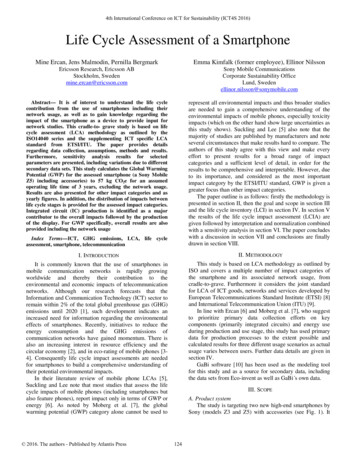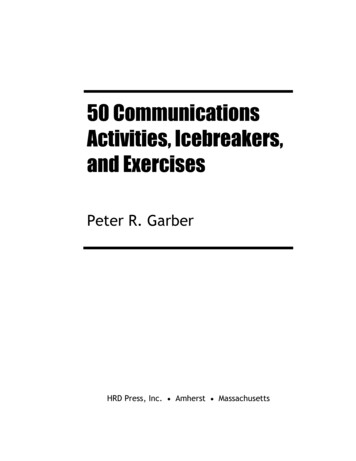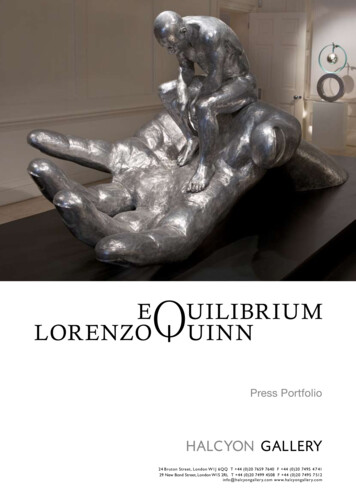
Transcription
Press Portfolio24LondonW1J6QQT 44(0)207659765976407640F 44F (0)207495 74954 7 4124BrutonBrutonStreet,Street,LondonW1J6QQT 44(0)20 44 (0)204129 New Bond Street, London W1S 2RL T 44 (0)20 7499 4508 F 44 (0)20 7495 47751229 New Bond Street, London W1S2RLT 44 (0)20 y.com7499 4508F 44 (0)20 y.com7495info@ halcyongallerwww.halcyongaller
ContentsPress CuttingsMarketing materialBillboard Advertising– The GuardianEvent Images– Country Life– The Observer– Art Times supplement (paid for)– BBC News Online– Art of England– BarcelonaReporter.com– AestheticaMagazine Blog– Despoke.com– Sydney MX– ArtRabbit.co.uk– HauteLiving.com– NYDailyNews.com– Tiscali.co.uk– Newstin.co.uk– Life.com– FAD Art Website– Bridteacher blog– Zimbio.com– Friendskorner.com (sharing site)– Treehugger.com24LondonW1J6QQT 44(0)207659765976407640F 44F (0)207495 74954 7 4124BrutonBrutonStreet,Street,LondonW1J6QQT 44(0)20 44 (0)204129 New Bond Street, London W1S 2RL T 44 (0)20 7499 4508 F 44 (0)20 7495 47751229 New Bond Street, London W1S2RLT 44 (0)20 y.com7499 4508F 44 (0)20 y.com7495info@ halcyongallerwww.halcyongaller
Press CuttingsLorenzo Quinn – EquilibriumThe GuardianThursday 19 November 200924LondonW1J6QQT 44(0)207659765976407640F 44F (0)207495 74954 7 4124BrutonBrutonStreet,Street,LondonW1J6QQT 44(0)20 44 (0)204129 New Bond Street, London W1S 2RL T 44 (0)20 7499 4508 F 44 (0)20 7495 47751229 New Bond Street, London W1S2RLT 44 (0)20 y.com7499 4508F 44 (0)20 y.com7495info@ halcyongallerwww.halcyongaller
Press CuttingsLorenzo Quinn – EquilibriumCountry LifeWednesday 18 November 200924LondonW1J6QQT 44(0)207659765976407640F 44F (0)207495 74954 7 4124BrutonBrutonStreet,Street,LondonW1J6QQT 44(0)20 44 (0)204129 New Bond Street, London W1S 2RL T 44 (0)20 7499 4508 F 44 (0)20 7495 47751229 New Bond Street, London W1S2RLT 44 (0)20 y.com7499 4508F 44 (0)20 y.com7495info@ halcyongallerwww.halcyongaller
Press CuttingsLorenzo Quinn – EquilibriumThe ObserverSunday 8 November 200924LondonW1J6QQT 44(0)207659765976407640F 44F (0)207495 74954 7 4124BrutonBrutonStreet,Street,LondonW1J6QQT 44(0)20 44 (0)204129 New Bond Street, London W1S 2RL T 44 (0)20 7499 4508 F 44 (0)20 7495 47751229 New Bond Street, London W1S2RLT 44 (0)20 y.com7499 4508F 44 (0)20 y.com7495info@ halcyongallerwww.halcyongaller
Press CuttingsLorenzo Quinn – EquilibriumArt TimesSaturday 21 November 2009This supplement is an independent publication from Raconteur MediaIMESNovember 21 2009ART & ARchiTecTuRe24LondonW1J6QQT 44(0)207659765976407640F 44F (0)207495 74954 7 4124BrutonBrutonStreet,Street,LondonW1J6QQT 44(0)20 44 (0)204129 New Bond Street, London W1S 2RL T 44 (0)20 7499 4508 F 44 (0)20 7495 47751229 New Bond Street, London W1S2RLT 44 (0)20 y.com7499 4508F 44 (0)20 y.com7495info@ halcyongallerwww.halcyongaller
Press CuttingsLorenzo Quinn – EquilibriumArt TimesSaturday 21 November 2009ART TIMESART & ARCHITECTURE 3Gaze on in wonderThe most compelling reason for art andarchitecture to interact successfully is a humanone, say Ian Banks and Kathryn TullyThere is no clear boundary forthe role or purpose for artin architecture, and neithershould there be. Historicallyit has been reflected largely by the governing interests of any era, whetherthat is culture, religion, war, socialrevolution or commerce. The relationship between art and architecture hasalways varied, influenced as much bycreative preferences as by the definingarchitectural movement of the day.Eric Gill, sculptor of Ariel & Prosperothat is integrated into the 1932 Art Decofacade of BBC Broadcasting House, oncesaid that artists were the “lap-dogs whosupply the ornamental knick-knacksand idols for which there will alwaysbe a demand”. Nowadays, such a beautiful and revered work would never beviewed as mere ornamentation, but thisillustrates how times and our culturalviewpoints change so relentlessly.Like it or not, the artistic enrichmentof buildings also depends on funding. Unlike many European countries,as well as many cities throughout theUS and Australia, there is no nationalPercent for Art scheme in the UK, although some regional, municipal andlocal authorities have developed suchprogrammes, requiring developers todevote a proportion of a new building’sconstruction costs to providing art.Does it matter that Richard Wilson’shighly evocative Turning the Place Overin Liverpool last year was funded out ofa regional marketing budget and not acultural fund? Perhaps not, given thatthe work, which featured a large circular chunk cut into the facade of a formerYates’s Wine Lodge rotating and turning,before occasionally slotting back perfectly into place, would never have beenrealized without such sponsorship.On the plus side, today’s artists andarchitects are finding themselves working together on increasingly integratedcollaborative commissions, sometimesto such an extent that neither the art orthe architecture asserts is predominance.Used constructively, this collaborationcan create a dynamic viewpoint that challenges the norm with new perspectives.Artists and architects are also increasingly ditching the idea that they shouldbe confined to one sphere or anotherand are exploring all the opportunitiesin between. Perhaps the most comprehensive example of the fusion betweenart and architecture can be seen in Japan. Here the boundaries of both artform and the role of the artist and architect have merged and transposed overrecent years. The work of renownedcontemporary architects such as ToyoIto, Shigeru Ban, Kazuyo Sejima andYoshio Taniguchi, and artists like FujikoNakaya and Tadashi Kawamata in particular, illustrate the future potential ofsuch creative possibilities.There are edifying examples of thecollaborative process between art andarchitecture all over the world, no lessin the Middle East, which is still forging its cultural identity through itsnew buildings. International sculptorLorenzo Quinn’s 2005 monumentalRise Through Education in Doha,Qatar, was conceived and created atthe same time as the new ASPIREAcademy for Sports Excellence andhas come to symbolise the building,the academy and this young country’scommitment to the education andsporting achievement of its youth.Quinn believes that the relationshipbetween art and architecture should bean evolving one. He wants his sculptures to change over time along withtheir permanent setting. Whether artis designed for a particular building, orjust derives more meaning in a certainspace, the interaction of the two is whatmakes it special and determines howwe respond, even if that interaction isso seamless that we take it for granted.After all, buildings derive theirmeaning from communities andfrom the relationship that the peopleliving in communities develop withthese structures. When art successfully interacts with architecture, thatrelationship is all the more enriching,enduring and personal for the peoplethat live in and around them, whichmust be the most compelling argument of all for making it work.Eric Gill,Ariel & Prospero,Broadcasting House,London, UKART & ARCHITECTUREPublisher: Dominic Rodgers editor: Kathryn Tullyeditorial consultant: Carlotta Cooper contributors: Ian Banks,Chris Lord, Eva Hagberg Design: Hervé BoinayFront cover image: Hand of God by Lorenzo Quinn, CaldeaBuilding, Andorra designed by architect Jean Michel RuolsPhotography by Eduard ComellasFor more information about Raconteur Mediapublications in The Times and The Sunday Times,please contact Dominic RodgersT: 020 7033 2100E: drodgers@raconteurmedia.co.ukW: www.raconteurmedia.co.ukThe information contained in this publication has been obtained from sourcesthe proprietors believe to be correct. However, no legal liability can be acceptedfor any errors. No part of this publication may be reproduced without the priorconsent of the Publisher. RACONTEUR MEDIA24LondonW1J6QQT 44(0)207659765976407640F 44F (0)207495 74954 7 4124BrutonBrutonStreet,Street,LondonW1J6QQT 44(0)20 44 (0)204129 New Bond Street, London W1S 2RL T 44 (0)20 7499 4508 F 44 (0)20 7495 47751229 New Bond Street, London W1S2RLT 44 (0)20 y.com7499 4508F 44 (0)20 y.com7495info@ halcyongallerwww.halcyongaller
Press CuttingsLorenzo Quinn – EquilibriumArt TimesSaturday 21 November 20094ART & ARCHITECTUREART TIMESART TIMESA history of coexistenceArt and architecture have influenced each other for over 2000 years and many oftoday’s visionary architects and artists completely reject conventional notions ofhow the two are different, finds Ian BanksAdiscussion of the confluence of art and architecture is by no means a newor faddish topic as theprinciples of art and architecturehave been intertwined for over 2000years. When, in 1487 Leonardo daVinci explored divine geometries inhis drawing Vitruvian Man, he wasreferencing the Roman architectVitruvius, who in his 25BC treatiseDe Architectura, called for “firmness, commodity, and delight” inarchictecture.Inspired by Florentine giants suchas Michelangelo and da Vinci, theDisegno movement, linked to design,advocated an intellectual search forartistic perfection. A seismic shifthad begun, and on the back of seminal works like da Vinci’s VitruvianMan and Michelangelo’s David, theoriginal Renaissance Man was born.Over the following centuries,while architectural principles continued to influence art, art withinarchitecture remained largely restricted to opulent ornamentation.It took until the 19th century andthe arrival of the Industrial Revolution before that limitation startedto change. Like Vitruvius’s De Architectura 800 years before, JohnRuskin’s hugely influential workThe Seven Lamps of Architecture,set out seven guiding principles forarchitecture, which he enlarged inThe Stones of Venice. He rejectedthe classical architectural traditionas pagan, proud and paralysed. Hebemoaned that such architecturemade plagiarists of its architects,slaves of its workmen, and “sybarites of its inhabitants”. In short, architects had lost the artistic impulse,the ability to create and to delight.Reacting to this, the Arts andCrafts movement was founded, withthe utopian vision of William Morris, to bridge the worlds of art anddesign. As the Industrial Revolutionwas seen to have separated humansfrom their creativity and individualism, so the Arts and Crafts movementsought to reestablish ties betweenbeautiful work and the worker.Many of the movement’s ideassoon found a resonance in architecture across Europe. Charles Rennie Mackintosh, influenced by themovement, not only designed theGlasgow School of Art, but the interior fittings as well. Across Europethese ideas evolved yet further intothe Art Nouveau style, again com-bining beauty with function, bestexpressed by visionary architectslike Otto Wagner in Vienna and Antoni Gaudi in Catalonia.After the First World War, theGerman Bauhaus school began linking ideas expounded by the Artsand Crafts movement, although ina more industrialised way. The Bauhaus was characterised by economicdesign and respect for materials andinspired both artists and architects,spawning the International Style ofvisionaries like Le Corbusier, and inpost revolutionary Russia, Constructivist artists like Vladimir Tatlin.Between the wars, the closer alignment of art and architecture broughton by the Arts and Crafts movementbegan to separate again. While thepragmatic architecture of Modernism,with its emphasis on form and function, was not out of place with the geometries of Mondrian’s De Stijl paintings, and Futurism was influencedby Cubism, the breakaway of otheravant-garde art movements like Dadaand Surrealism began to set Modernist architecture apart on its own.By way of illustration, when thearchitect Mies Van der Rohe created his Barcelona pavilion for the1929 International Exposition, hefilled it with nothing other than onefigurative sculpture by Georg Kolbeand the iconic Barcelona Chairs designed by him. “Nothing will be exhibited, the pavilion itself will be theexhibit”, he famously explained tohis commissioners. Only Art Decocontinued to burn a candle for acloser alignment with the decorativeand industrial arts.Following the renewed destructionand misery wrought by the SecondWorld War, European intellectualsagain explored revolutionary ideas.The anarchic Situationists, like theDadaists and the Surrealists beforethem, wanted to reintegrate art backinto everyday life. From that point on,notions of art and architecture onceagain started to merge. A range ofvisionaries as diverse as Frank LloydWright, Le Corbusier, Frank Gehry,Daniel Libeskind, Zaha Hadid, KurtSchwitters, Vito Acconci, Christo andJeanne-Claude, Gordon Matta-Clark,Peter Cook and Will Alsop have eachcontributed to a slow deconstructionof the boundaries.That has resulted in artists actingas architects and architects designing buildings from an artist’s perspective. For example, the artist VitoAcconci has long been devoted toarchitecture and design, which culminated in the creation of his spectacular Mur Island, a floating exhibition and performance space in Graz,Austria. Conversely, architect FrankGehry’s ubiquitous Museo Guggenheim in Bilbao is as importantand as beautiful a work of art as itscontents, demolishing preconceivedideas of where art and where architecture belong in a museum.Today, the way in which art andarchitecture is combined has become ever-more diverse and eclectic.An artist’s contribution to a building, for example, can still be decorative or sculptural, yet on the otherhand, collaboration can be highlyintegrated, like John Pawson’s HotelPuerta America in Madrid, whichshowcases the work of 19 of theworld’s top architects and designers, including Norman Foster, ZahaHadid, Ron Arad and Marc Newson,among others.Increasingly it is experimental, suchas Diller and Scofidio’s Blur Building designed with Fujiko Nakayafor the 2002 Swiss EXPO. Visitorswalked down a long ramp to accessthe Blur Building, an open air platform suspended over Lake Neuchatelin Switzerland, shrouded in a c
– Friendskorner.com (sharing site) – Treehugger.com Marketing material Billboard Advertising Event Images. 24 Bruton Street, London W1J 6QQ T 44 (0)20 7659 7640 F 44 (0)20 7495 4741 29 New Bond Street, London W1S 2RL T 44 (0)20 7499 4508 F 44 (0)20 7495 24 Bruton Street, London W1J 6QQ T 44 (0)20 7659 7640 F 44 (0)20 7495 4741 29 New Bond Street, London W1S 2RL T 44 (0)20
